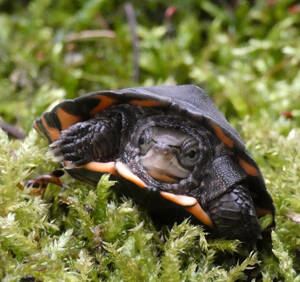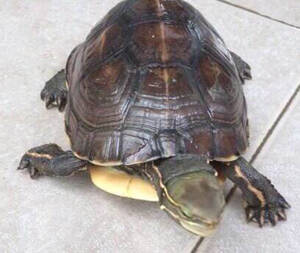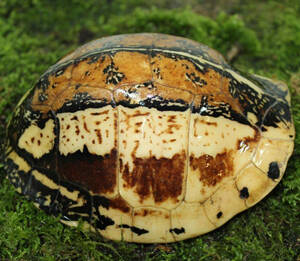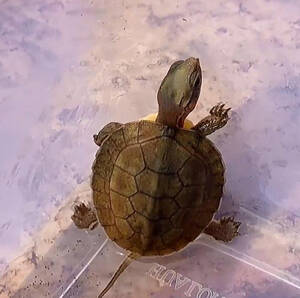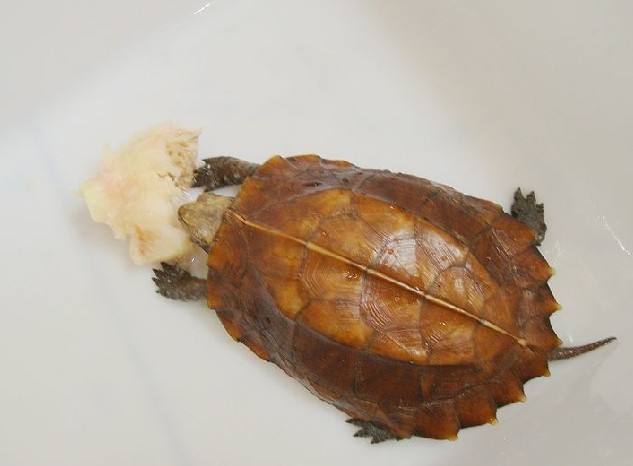Sacalia quadriocellata
IUCN
LCBasic Information
Scientific classification
- name:Sacalia quadriocellata
- Scientific Name:Sacalia quadriocellata,Four-eyed Turtle,Six-eyed turtle, four-eyed turtle, four-eyed spotted turtle
- Outline:Testudines
- Family:Testudinidae genus
Vital signs
- length:12-13cm
- Weight:300-500g
- lifetime:About 50 years
Feature
The head and neck are brown-olive in color, with two pairs of eye spots closely arranged on the back of the head.
Distribution and Habitat
Distributed in China, Laos, and Vietnam.
In China, it is distributed in Fujian, Jiangxi, Guangdong, Guangxi, Hainan, Zhejiang, Jiangsu, etc.
Appearance
The carapace length is 122-135 mm in males and 130-134 mm in females; the width is 76/84-84/92 mm in males and 73/85-85/95 mm in females; the height is 42-51 mm in males and 45-53 mm in females; the head width is 16.5-21 mm. The head is smooth and scaleless; the snout is short and pointed, extending beyond the lower jaw and vertically downward to the edge of the beak; there are two pairs of obvious eye spots on the back of the head. The carapace is relatively flat, with obvious ridges and weak and inconspicuous lateral ridges; the nuchal shield is narrow and long, with the rear edge wider than the front edge; there are 5 vertebral shields, which are wider than long, and the first vertebral shield is pentagonal, wide in front and narrow in the back; there are 4 pairs of costal shields; there are 11 pairs of marginal shields; there is 1 pair of hip shields. The plastron is flat, slightly shorter than the carapace, with a flat front end and a slightly concave rear edge; the suture of the
Details
Four-eyed turtle is called Four-eyed Turtle in foreign language, and has no subspecies.
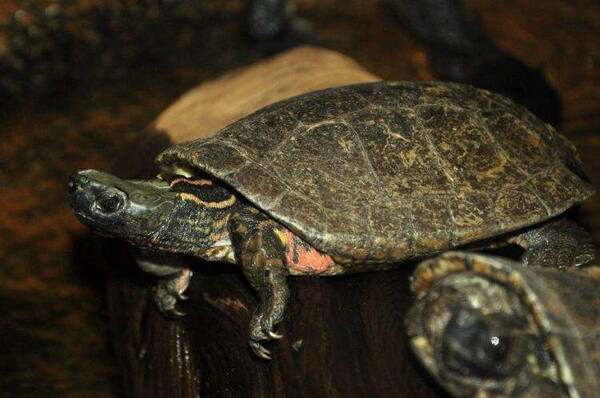
In nature, four-eyed turtles like to live in pits and ditches in mountainous and hilly areas, and often live in dark places, such as under stones and in tree roots. The four-eyed spotted turtle is very timid. Once frightened, it will immediately retract its head, tail, and limbs into its shell or quickly escape. At the end of April every spring, when the water temperature rises to 15℃, it begins to wake up from hibernation and crawl around, but its range of activities is not large. When the water temperature rises to above 18℃, it begins to forage. In the afternoon when the weather is clear, it likes to lie on the shore with its head raised and its limbs stretched out to bask in the sun. At the end of October, when the water temperature drops to 15℃, it begins to hibernate. The hibernation site is chosen in deep water or under a sheltered, sunny cave or haystack on the shore. During hibernation, the head retracts into the shell, and the limbs and tail are exposed, and it is not very sensitive to environmental changes.
The four-eyed spotted turtle has a very diverse diet and a small appetite. It usually likes to eat animal bait the most. In the natural environment, it mainly feeds on small fish, shrimps, and aquatic insects. When food is scarce, it also eats some small wild fruits.
The maturity age of the four-eyed spotted turtle is 4 summers in southern China, 5 summers in eastern China, and longer in northern China. The weight is generally about 500 grams. Mature parent turtles begin to estrus and mate in mid-May every year. Mating is generally carried out in open water or on a quiet shore. During mating, the male turtle first circles around the female turtle or stands in front of the female turtle, facing the female turtle, stretching his head and neck, moving up and down or shaking left and right to prevent the female turtle from crawling. When the female turtle is still, the male turtle will quickly go behind the female turtle and climb onto the back of the female turtle. At this time, the male turtle's forelimbs hook the front edge of the female turtle's carapace for mating. Egg laying begins in mid-May and ends at the end of August. Egg laying is mostly carried out in the sand on the sunny and leeward river banks. Eggs are laid 1-3 times a year, 2-5 eggs each time. After laying, the fertilized eggs will be hatched with the help of the heat of natural sunlight, which generally takes about 70 days.
Listed in the "IUCN Red List of Threatened Species" (IUCN 2000 ver 3.1) - Endangered (EN).
Listed in the "Convention on International Trade in Endangered Species of Wild Fauna and Flora" (CITES) (June 23, 2010) - Appendix III.
Listed in the "Convention on International Trade in Endangered Species of Wild Fauna and Flora" (CITES) (November 26, 2019) - Appendix II.
Listed in the "China Biodiversity Red List - Vertebrate Volume" (Reptiles) - Endangered (EN).
Listed in the "National List of Terrestrial Wildlife with Important Economic and Scientific Research Value" issued by the State Forestry Administration of China on August 1, 2000.
Listed in the second level of the "China National Key Protected Wildlife List" (only for wild populations).
Protect wildlife and eliminate game.
Maintaining ecological balance is everyone's responsibility!



